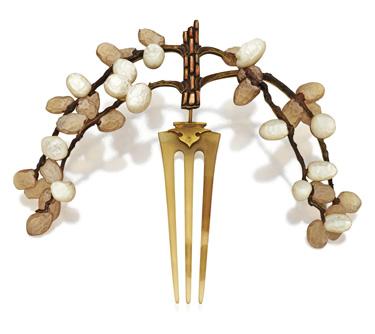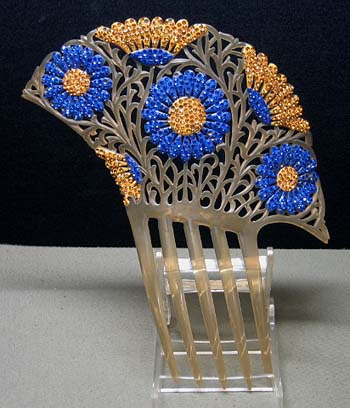A few months ago, this set of tortoiseshell hair pins with pearls and diamonds, priced at $1200, went unsold. I understand the jewelry was real, but the design is common. If you value just the pearls and those small diamonds, they don’t amount to very much. Neither do two small shell pins, not $1200 anyway. I think you’d need a great design and a makers mark + the jewelry to command that price. But they were pretty. :-)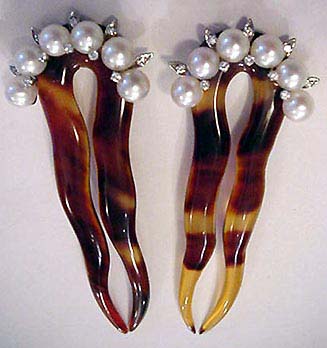
This comb’s art nouveau decoration is absolutely gorgeous. The top is 14K gold in a wave ribbon with small enamelled pink flowers and green leaves, set off with pearls. It went unsold at $895. Condition: Perfect. I like $650 as a price for this. Retail? Who knows. There is this shop online called Isadora’s. I saw combs like my gold dragon one with the ruby eyes go for $2200, and someone paid it. Isadora’s markets itself as a wedding shop, and when someone is in wedding frenzy, I guess they will pay anything. ;-) So who is really to say, but this is a beautiful comb. 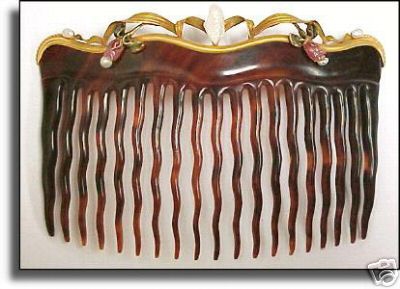
Category Archives: French Hair Comb
My Collection and Latest Grab :-)
Here are the combs in my coffee table vitrine. :-)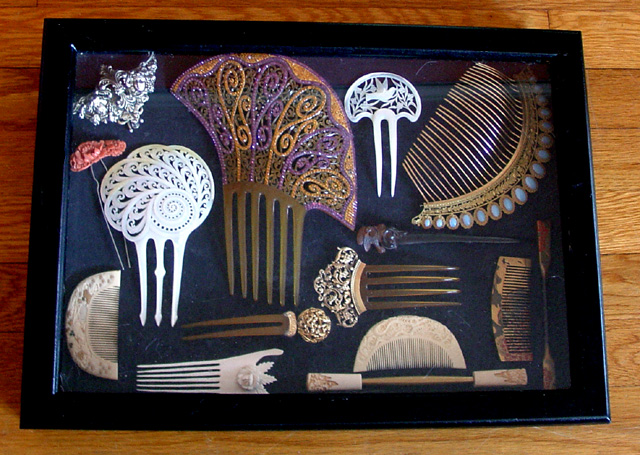
Also, here is my latest grab. I sniped it. I know some of the people who bid, and I think they cursed my name. ;-PPPP No, I jest. But I love the colorful, bold, flamboyant art deco celluloid combs. I’m going to bet this one is English. The best designer in this style of course is the French artist Auguste Bonaz. But I loved this ‘blue and orange flowers on a vine’ comb. We’ll end the night with some color. Price: $135.
Four French Combs
There have been some lovely French combs available from various shops online. On Feb 18, a beautiful French art nouveau enamelled bird on a tortoiseshell pin, offset with glass stones, sold for $513. Too much for me in one bite. I didn’t win. :-( But this one is definitely worth noting. It was sold by ancient-arts and bought by stealthwon. I think someone could build an entire collection around birds if they wanted to.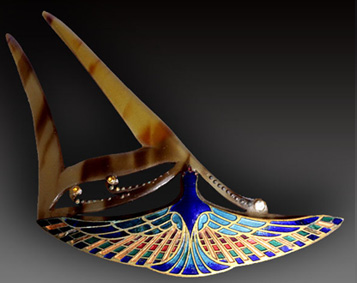
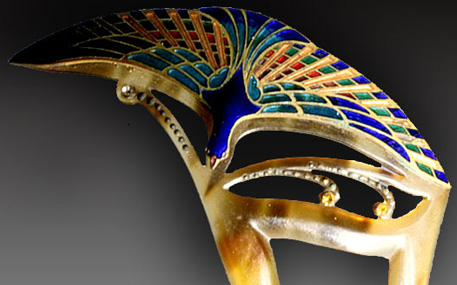
A friend of mine bought this c. 1870 French Fleur de Lis comb, which is made of shell with gold accents, on Ruby Lane for $350. I think it’s especially elegant.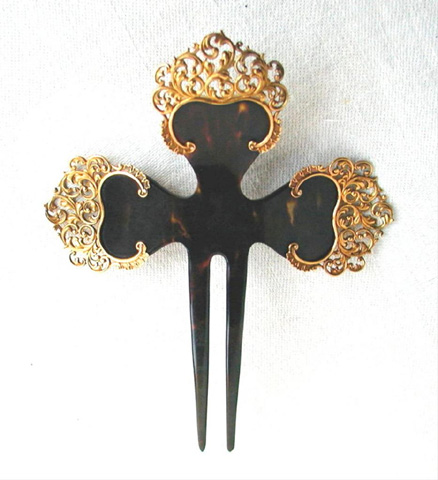
This is a French brass hair pin, c. 1880, which was sold at my friend Sue Marie’s shop LeBoudoir on Ruby Lane for $300. The hair pin depicts wheat. I really like this one because of its unusual subject. I should have bought it.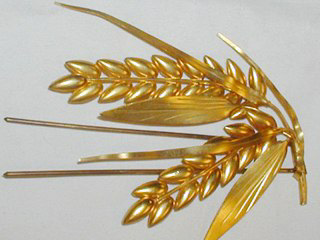
And last but not least, is this lovely French tortoiseshell back comb, c, 1880, which I’m arranging to buy from Ruby Lane. I like the shape. I have an English back comb, and I love getting similar things from different countries to compare how different cultures approached the same design challenge.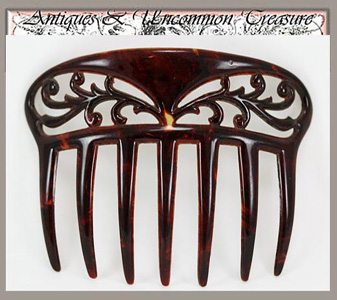
Final Prices at Sothebys
We’ve been following a lot of combs sold at Sotheby’s auctions. I thought it might be useful to list their final sale prices to get a sense of the comb market. Like any antique, the highest prices went to pieces that were made by the hands of a master who changed the way the world thought about art. The great masters made combs-as-jewelry and combs-as-ideas. Each thumbnail photo will be linked to the original post, so everyone can see the description.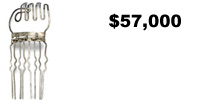
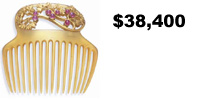
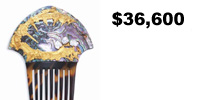
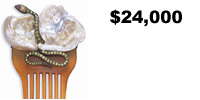
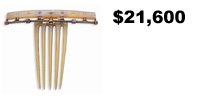
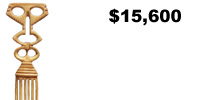
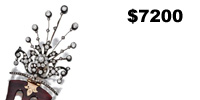
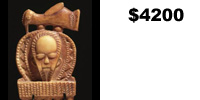
Some Lovely Things on Ebay
Here is the most recent set of beautiful combs, which were listed on ebay. Also listed was a drawing of a horn hair comb with notes in Rene Lalique’s own hand, from his family’s collection.
Tortoiseshell comb, c. 1850, with intricate hand-carved openwork design and real rubies, diamonds, and sea pearls. It sold for $405 on Nov. 16. 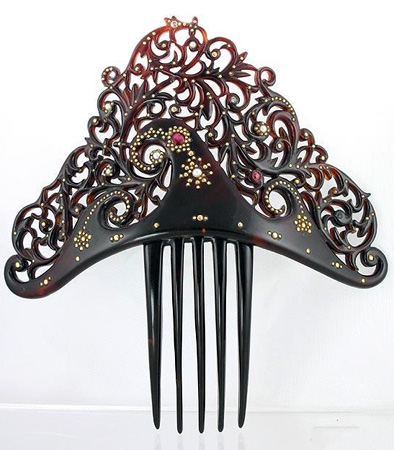
Joseph Rodgers’ hallmark is on this Sterling silver comb, c. 1898. The comb is small, about 3.34″ wide by 3.1″ high. It sold for $68.02 on Nov. 12. 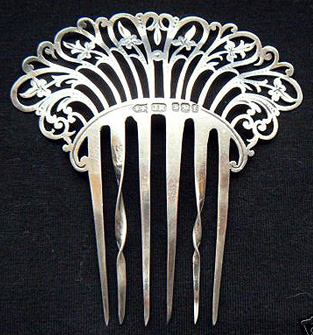
Design for a horn hair comb, ink and watercolor on BFK Rives parchment paper, with annotations in Lalique’s hand, upper right, c. 1900. (Provenance: Lalique Family collection.) It sold for $4000 on Nov. 17. 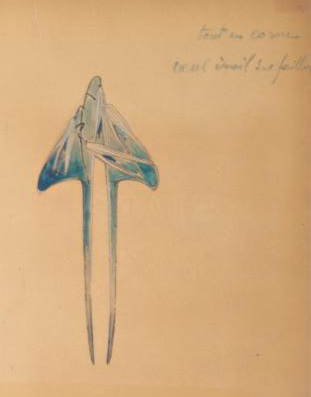
Mary’s Bonaz Comb
I am delighted to present this post by Mary Bachman, president of the Antique Comb Collectors Club. She wrote one of the definitive books on European combs called, “A Collectors Guide To Hair Combs.” I’d recommend buying this book because she has a beautiful collection, and it is also a price guide.
Mary wanted to share one of her Auguste Bonaz combs with us. She writes, “Auguste Bonaz was a designer of hair ornaments during the early 20th Century. His designs are very popular with collectors. His company was located in Oyonnax in Eastern France where he designed for leading jewelry makers. After World War I his business expanded and the demand for his combs continued to grow. Even though ladies were bobbing their hair, his combs continued to be popular. His designs are varied and delightful. Bonaz died in 1922, but his wife carried on his business using only his original designs. His nephew managed the business until 1982 when it finally closed. (Reference: Jen Cruse article in the Antique Comb Collector, June 2000).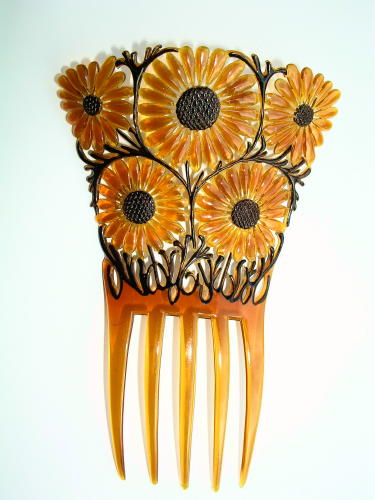
French Art Nouveau Combs
I guess our journey is taking us from the stunning frieze-like ivory carvings of Medieval France to the free-form celebration of nature in France at the turn of the century.
. These combs have been documented in Michael Koch, The Belle Epoque of French Jewellery 1850-1910.
Rene Lalique: Art-Nouveau horn, pink sapphire, and gold hair comb, c. 1902: Final Sale Price: $38,400. “The wide rectangular horn comb is surmounted by a curvaceous openwork floral design of gold leaves and stems, with cabochon pink sapphire berries, mounted in gold.” I think the reason the pussy willow Lalique in an earlier post is $330,000 is because he made that one with his own hands. These might have been made for his company. 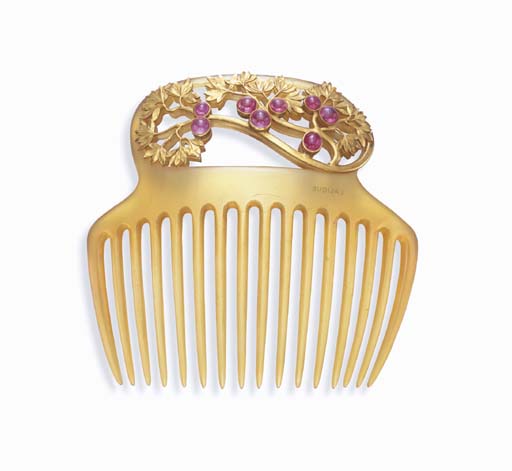
Georges Fouquet: mother-of-pearl and gold comb, probably from a design by Charles Desrosiers. However, in one book the maker is listed as Aristide-Lionel Le Couteux. Fouquet could have been the retailer, c. 1905: Final Sale Price: $33,600. “Designed as an iridescent pink, green and blue mother-of-pearl fan-shaped panel, enhanced by textured 18k gold organic rays with three baroque pearl accents, to the tortoiseshell comb, with French assay mark and maker’s mark. Signed G. Fouquet.” 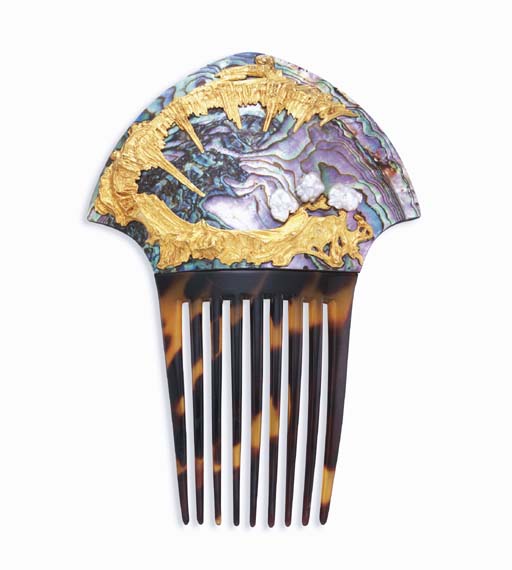
Rene Lalique: horn, topaz, diamond, and gold hair comb, c. 1902: Final Sale Price: $21,600 “Composed of a rectangular horn plaque, carved as four dragonflies with gold thoraxes, enhanced by a rose-cut diamond and gold bar, set with rectangular-cut brown topaz, to the horn comb in a Lalique beige suede fitted case. Signed Lalique for René Lalique.” 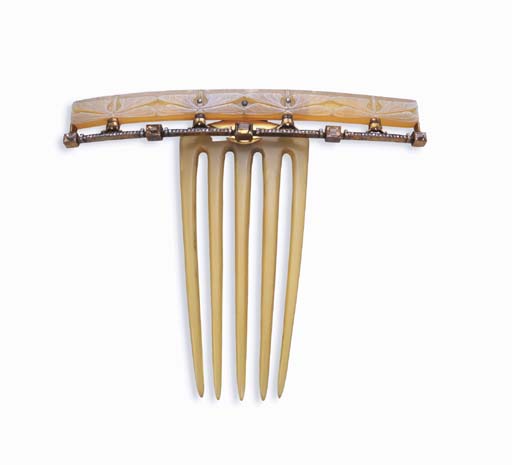
Charles Boutet de Monvel: Mother-of-pearl, peridot, and tortoiseshell comb, c. 1900: Final Sale Price: $24,000 “Composed of a mother-of-pearl oyster shell, centering upon a serpent set with peridots and green paste, with a cushion-cut citrine head and two cabochon ruby eyes, to the tortoiseshell comb, mounted in silver. Signed Boutet de Monvel for Charles Boutet de Monvel “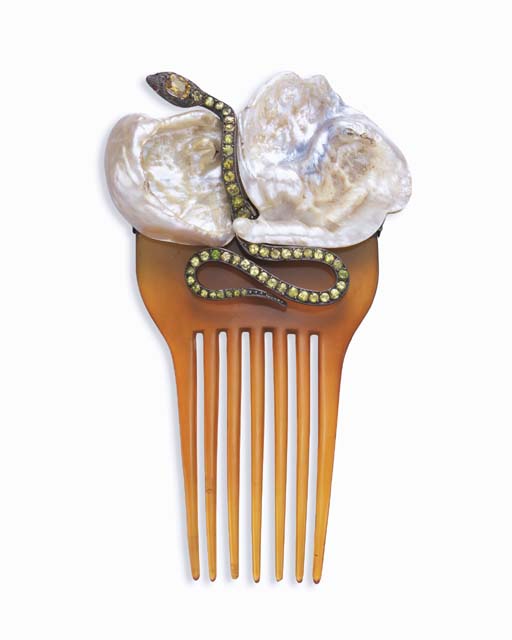
The H Combs of Medieval France
The H comb, with tines for thick hair on one side and thin hair on the other, is one of the comb’s earliest known forms. The art was in the H, and the form can be found in all cultures. H combs are still made today in Turkmenistan, and you can see one from time to time on ebay. The H casing is silver or gold plate with gemstone cabachons in the middle.
However, today, I want to talk about the H combs of 15th-century France. They were liturgical with elaborate, stunning carvings of the Adoration of the Magi, and were made from ivory and wood. They were made when the Church ruled art and music and followed the progression from sacred to secular as the Medieval Period gave way to the Renaissance. You can only find them in museums.
St. Albans, Peigne liturgique en ivoire, c. 1120. Used in religious ceremonies, the carving represents the Massacre of Innocents, Adoration of the Magi. From the Victoria and Albert Museum.
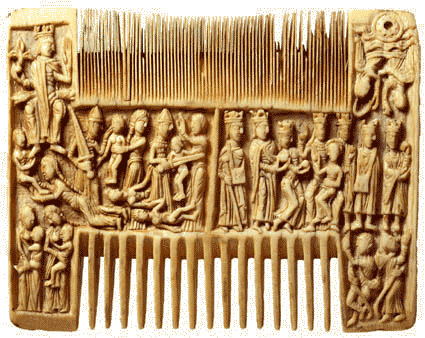
Annonciation – Adoration des Mages, ivory, 15th Century, Anonymous, The Louvre, Paris.
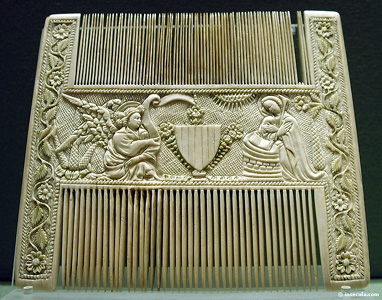
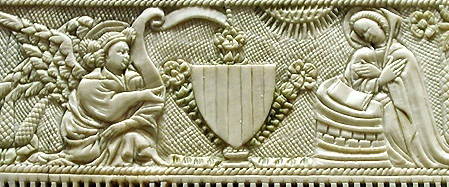
Liturgical combs were also made of wood, some with mirrors in the middle or ivory inlay.. The wood appears to be about 1/2 inch thick in the middle, tapering to 1/8 at the tips of the teeth. These 15th Century combs reside in The Musée National du Moyen Age – Thermes de Cluny.
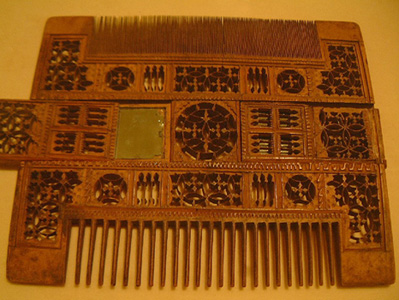
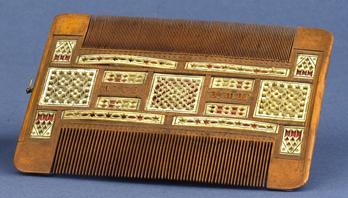
In the late 15th century, you start to see secular decorations in the H combs, as with these three examples:
Lovers in a Garden, French, Ivory, Anonymous, from the Victoria and Albert Museum.
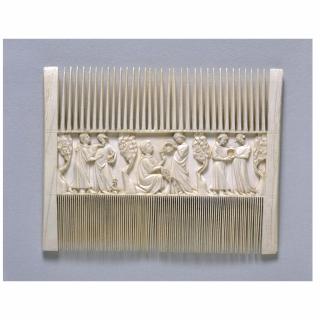

Ivory comb with two jousting swordsmen, France, from the Fundación Lázaro Galdiano in Madrid.
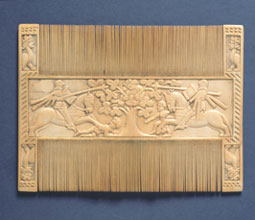
Ivory Comb, openwork, France, 16th century, from the Fundación Lázaro Galdiano in Madrid.
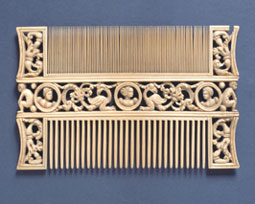
For The Birds
Man’s love affair with creating birds started with the earliest cave paintings. They are everywhere, and have always been a major theme in comb making. Recently, a beautiful ivory bird comb, Chinese c.1870, sold for $350. It got me thinking about doing a collection of bird combs on the blog. A friend of mine graciously sent me pictures of bird combs in her private collection. I own two bird combs, and there is a remarkable swallow comb at The Tadema Gallery in London. So here they are… the birds.
Mythical Bird on Edo Kogai stick, c. 1850
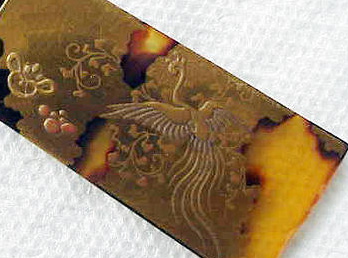
Ivory bird comb, Chinese, c.1870, sold Sept. 30, 2006 for $350, ebay.
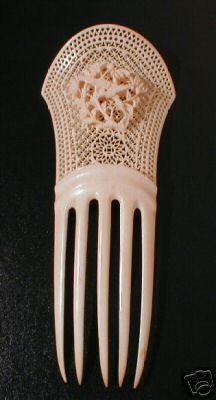
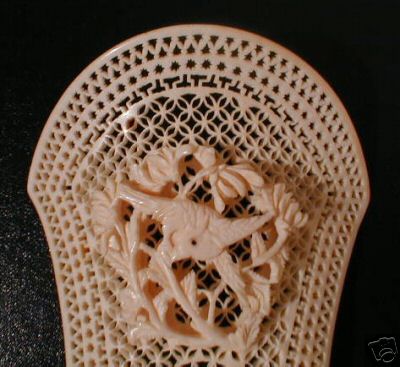
Ivory Bird on a bamboo tree, Chinese, c. 1870, a private collection.
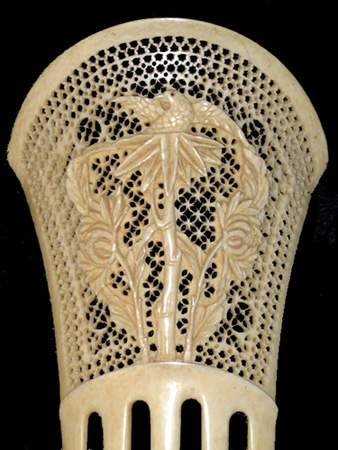
Tortoiseshell Bird on a stick, Italian, c.1870, my private collection.
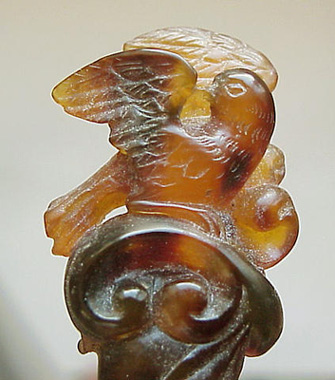
Ivory birds in a flower garden, Chinese, c. 1880, a private collection
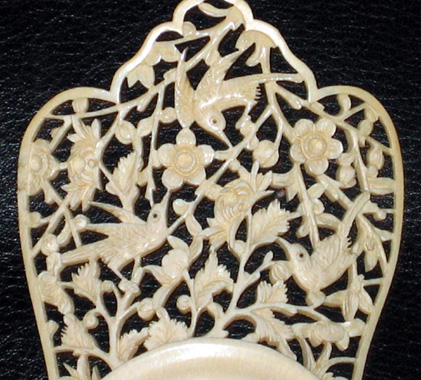
Black Crow on a Meiji Kushi, c. 1890
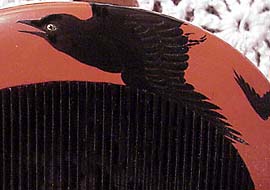
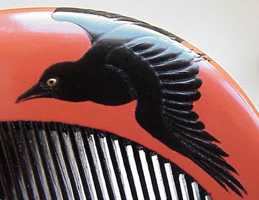
Silver filigree, micromosaic decoration, Italian, c. 1898.
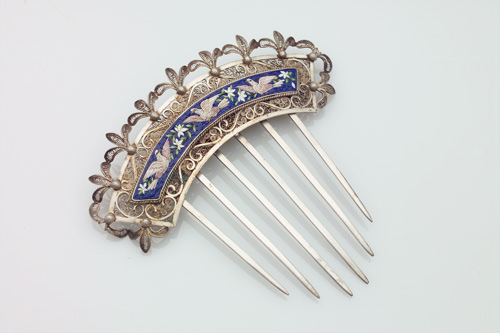
Swallow Comb, c. 1900, gilded silver and plique-a-jour enamel, from the British Arts and Crafts period, The Tadema Gallery, London. The price range for this comb is 2,500 to 5,000 British Pounds Sterling.
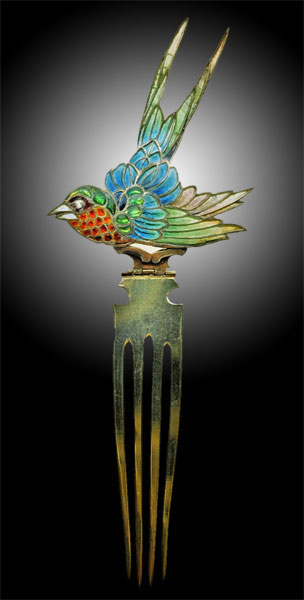
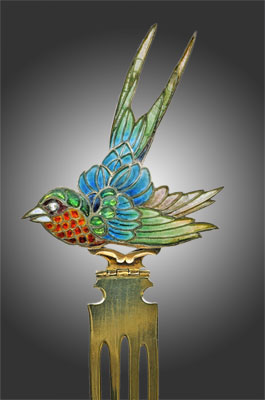
Three art deco parrot combs, celluloid, c. 1920, a private collection.
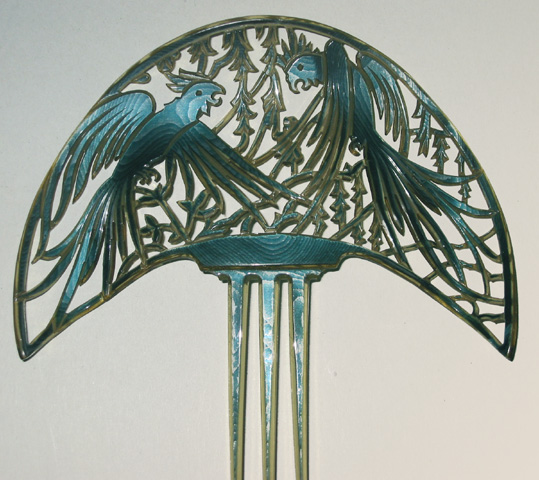
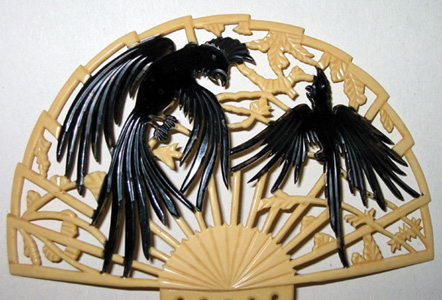
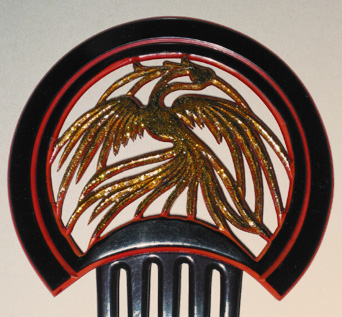
Rene Made This With His Own Hands
Well, sometimes your mind explodes. I would have never thought a comb Rene Lalique made with his own hands would come to public auction. I would have thought a museum would grab this for their lives before any competition would find it.
Here it is: “Rare Horn, Mother-Of-Pearl, Enamel and Topaz Tiara, Circa 1903, Rene Lalique.” Estimate: $330,000.
Description: “Naturalistically designed as branches of pussy willows, the trunk bark defined by wedge-shaped topaz offset by a brown enamel field, continuing to carved gold and horn branches painted with brown enamelling, punctuated with carved mother-of-pearl and horn pussy willows in various stages of bloom, the three-prolonged comb of horn, connected to the diadem by a gold hinge, signed”
It went to Albion Art’s Virtual Museum.
From Diana Scarisbrick: “A French Art Nouveau horn, mother of pearl, enamel, topaz and yellow gold diadem by René Lalique, designed as two stylised trailing willow (Salix) stems, the three pronged hinged horn comb supporting a textured yellow gold trunk set with three rows of baguette-cut topaz from which emanates to either side two trailing branches of carved mother of pearl and horn catkins in various stages of development, signed ‘LALIQUE’.
“In his quest for a new style of jewellery, Lalique challenged the conventional tiara crowning the heads of women at formal events, signifying their wealth and status. The alternative he offered here is inspired by the commonest of trees, the willow. As in nature, he attaches two leafless branches complete with catkins to the bark of the tree, and places them so that they rise above the brow, drawing attention to the head, not through the glitter of diamonds, but by the sheer originality of the motif. Similarly typical of his independent style are the materials used – mother of pearl, horn, enamelled gold – which are inexpensive and relatively humble. The three pronged transparent horn comb below is hinged so as to lie flat on the crown of the head and support the arched ornament framing the face. These jewels for the hair were popular and it is significant that of the nine combs Lalique showed at the exhibition held at Agnew’s in London in 1905, no less than eight were made of horn.”
